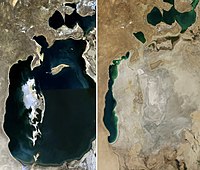
Photo from wikipedia
Ecosystem collapse, i.e. the endpoint of ecosystem decline, is a central concept of IUCN Red List of Ecosystems (RLE) assessments and the identification of ecosystems most vulnerable to global environmental… Click to show full abstract
Ecosystem collapse, i.e. the endpoint of ecosystem decline, is a central concept of IUCN Red List of Ecosystems (RLE) assessments and the identification of ecosystems most vulnerable to global environmental change. Estimating collapse risk can be challenging for ecosystems reliant on a few dominant species to perform most of their functions because the range of suitable and feasible indicators is small. This study investigates the robustness and adequacy of the current RLE approach for risk assessments in such ecosystems, using a fringe mangrove ecosystem as a case study. Following the RLE protocol, we constructed a conceptual model of the key ecosystem processes for the Philippines’ fringe mangrove forests. Satellite remote sensing data and existing maps of mangrove forests were then combined to assess the spatial distribution of the ecosystem considered (Criteria A and B), while the Normalized Difference Vegetation Index was used to assess biotic degradation (Criterion D). Insufficient data were available to assess Criteria C (environmental degradation) and E (quantitative analysis). Overall, the ecosystem was assessed as ‘Least Concern’ based on extensive geographic distribution and only weak support for declines in extent. Criterion D was classed as ‘Data Deficient’ since there was no clear relationship between the vegetation index and fringe mangrove degradation. Our results demonstrate how gaps in our appreciation and understanding of the structure and functioning of ecosystems are more likely to impede risk assessments of ecosystems characterised by a small number of foundation species, due to the low level of redundancy between candidate indicators available for their assessments. Satellite remote sensing combined with derivation of explicit conceptual ecosystem models provides a way to structure efforts to identify suitable indicators as well as opportunities to overcome many of these challenges, even for relatively data-poor ecosystems.
Journal Title: Ecological Indicators
Year Published: 2018
Link to full text (if available)
Share on Social Media: Sign Up to like & get
recommendations!